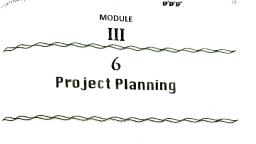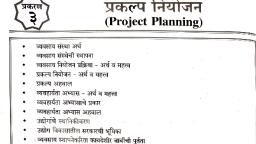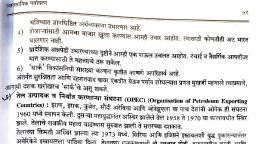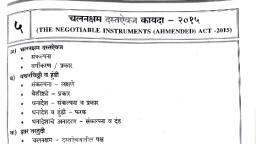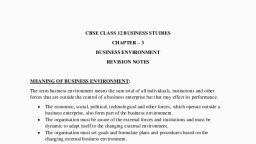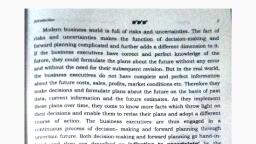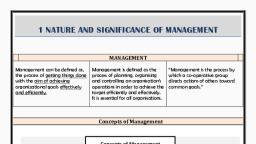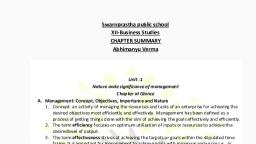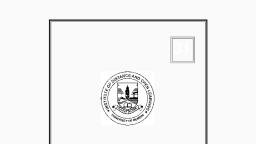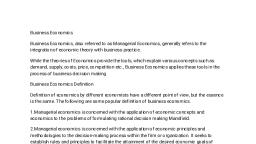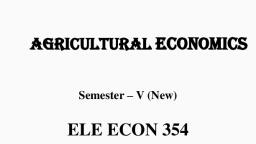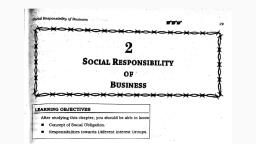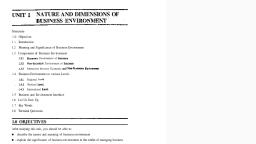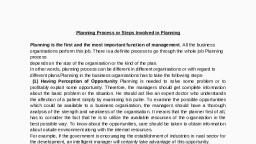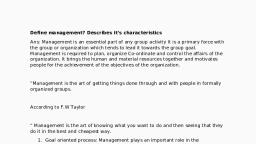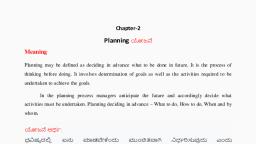Page 1 :
44, , Introduction, , SP'SP'S, , to, , Business, , (Paper-) (F.Y.B.Com.) (S., , (Sem.-, , MODULE, , II, , 4, Business Environment - 1, , SYNOPSIS, , Meaning, Definitions, Features, , Components, Interface between Business and Environment, Educational environment and its impact, on business, Impact of business on Education, , Free!!!, , Questions and Ansuwers available with soratch, eard provided, , instructions provided for downloading, , in the, , book. Please, , tollou
Page 2 :
MEANING, Business, , environment, , nmeans, , the, , surroundings within which the business operates. It, various external factors within, which a business is to be, operated upon. Understanding the environment, within, which the business has to, is very important tor, a, is, , basically, , a, , sum, , total of, , operate, running business, successfully. The environmental factors, influence almost every aspect of business,unit, be it its nature, its, of, location, the, oroducts, the distribution system, or the, personnel policies. Hence it is importantprices, about the various components of the, to learn, business, , environment,, The term "business, environment' connotes external, forces, factors and institutions, that affect the functioning of a business, These include customers,, enterprise., suppliers, gOvernment, and the social, political, legal and, competitors,, factors etc. While, technological, some ot these factors or forces, may have direct influence over the business, firm, others, may operate indirectly. A business, has limited control over the external, organisation, environment. What it can manage and control are the, various internal environmental, factors., While, , an, , environment has considerable impact and, influence, , on the, scope and, several, constraints on its, functioning. The organisation, on the other hand, imposes, has very little control over its, environment. Therefore the basic job of the, organisation is to identify itself with the, environment in which it operates, and to formulate, its policies accordingly., , directions, , of the, , activities of the, , organisation,, , it also, , DEFINITIONS, K, , According to Davis, Keith: Environment of the business means "the aggregate of all, , conditions, events and influences that surround and affect it.", , 2, , According to B.0. Wheeler Business Environment is "the total of all things external, firms and individuals, which affect their organisation and, , operations, , to, , 3, , According to Arthur W. Weimer: "The business environment is the climate or set of, conditions; economic, social, political or institutional in which business activities, are conducted.", , 4., , According to William F Glueck and Lawrence R. Jauch: "The environmentincludes, factors outside the firm which can lead to opportunities for or threats to the firm., Although there are many factors, the most important of the factors are socio-, , economic, technological, supplier, competitors and government", , FEATURES OF BUSINESS ENVIRONMENT, 1., , Environment is an integral part of business, , Business environment refers to the socio-economic surroundings under which, business activities are conducted. Businesses cannot work in isolation. Both, business and, ts environment are interdependent on each other. Business is not only influenced by its, , environment but also cannot function without it., 2., , Dynamic, Environmental, , factors, , environmental factor has a, , are, , dynamic. They keep, , corresponding effect, , on, , on, , the working, , of electronic products where changes take place, of today becomes a thing of past within no time., , in the, , 3., are, , case, , Complex, , A change in the, of the business as is seen, innovation, pace. An, , changing., at a, , rapid, , Technological changes, Business environment is also complicated and unpredictable., not only a r e, enacted everyday and, a rapid pace, n e w legislations a r e, at, taking place
Page 3 :
46, , Introduction, , SP'SP's, , to, , Business, , (Paper-) (E.Y.B.Com.) (Sem, , consumers becoming aware of their rights but economies are become global. Such fa., have made the environment complex., , factor, , 4., , Multi-dimensional, , Changes in business environmernt can be perceived both as an opportunity or ., it provides opportunities on one hand, it also creates problems on, the otho, A change in the environment may be beneticial to one, organisation but the same mav h, , threat. While, , challenging to the other. For example, liberalisation has opened the doors of glohal, markets for the Indian business organisations; at the same time many, been allowed to sell their products in India. This has intensified the, has made survival of the domestic industries difficult., 5., , multinationals hava, competition, which, , Long lasting impact on business, , Changes in the environmental factors can have a long lasting and sometimes, permanent impact on the functioning of the business. For example, liberalisation policies, privatisation, delicensing of industries etc. adopted by the government of India has had a, direct and long lasting, on the, and future, , impact, , 6., , Environmental, , organisations, a, , present, , Above business influences, , limited, , economic, , factors, especially, , prospects of many companies., , the external, , uncontrollable. Business., position to influence them but tocommunity is not satisfied with a particularand cartels it can put, pressure on the government to, , cannot control them. At times, they, extent. For example, if the business, , policy, by forming pools, , are, , ones, , in, , are, , a, , modify it., 7., Affects business planning, Environment and planning are, closely interlinked. As the environment affects, business planning, plans should, ideally be prepared after analysing the externa, environment. Planning has to, keep pace with the changes in the environment so as t, derive maximum, from the, benefits, opportunities created by the environment arnd to tac=, the, 8., , problems created by an unfavourable environment., Regulates the scope of business, , Environment provides the frame-work within, which business organisations have to, operate. Business activities have to be, as per the, adjusted, prevailing environment. For, example, manufacturers of products like, and, on, , 9., , television., , alcoholic drinks, cigarettes, Such regulations must be taken, into account., , cannot advertise, , Uncertainty, , Business environment is, largely uncertain as it, happenings, especially when environment changes areis very difficult to predict futurs, the case of information, taking place too frequently as in10., , technology or fashion industries., , Relativity, , Business environment is, , and even, region to, in China or Pakistan., , region., , 4.2., , relative concept since it differs from, country to country, Political conditions in the USA, for, instance, differ from those, a, , CONSTITUENTS OF BUSINESS, ENVIRONMENT, , Business environment had two, broad, external environment. These, A., , components, , explained as under, INTERNAL ENVIRONMENT, are, , It refers to all the, factors within, , tactors are, generally, factors. Some of the, , i.e., , internal environment, , ana, , organisation which affect its functioning. These, regarded controllable i.e. the organisation can alter, or, modity such, important internal factors are:, as, , an
Page 4 :
Value system is a set of consistent ethical values followed by an individual or ar, , rganisation. It means the value of the organisation in the eyes of the employees., Internal tactors that enhance the value system are the loyalties, professionalism, WOrk, ethics, security measures, structure of wages, perquisites and the overall employee, , org, , satisfaction., , 2., , Management philosophy, Management philosophy influences the functioning of the business organisation to a, , 2reat extent. A management that adopts an orthodox approach. uses traditional and old, fashioned practices to carry on its business. Whereas the management that adopts a, , professional approach gives more importance to social obligations which is more suitable, , in today's competitive business environment., 3. Vision, Mission and objectives, A vision statement highlights the long term goals of the organisation. It is broad, based and provides necessary directions to the business. On the other hand, short term, to as mission statements. A mission, reterred, statement provides directions in, setting objectives and framing policies of the organisation. There must be consistency, , targets are, , between the, , vision statement,, , the mission statements and the, , objectives of the, , organisation., , 4., , Human resource, , Manpower is one of the most valuable assets of an organisation. Success of the, The attitudes and skills of the, of its work, upon the, organisation, employees affect the functioning of the business organisation., , depends, , 5., , force., , quality, , Internal relationship, , This includes the relationship among the three levels of the organization. The mutual, co-ordination among these levels is an important need for a business. The relationship, of the organization should be cordial. There, among the people working in the three levels, , has tobe a proper flow of vertical and horizontal communication. i.e. between superiors, and subordinates and between colleagues at the same level., 6., , Corporate image, , is the perception that the consumers, investors, suppliers and, other social groups including the company's employees have about the company. A, will be beneficial for the organisation itself, not only in the short, , Corporate image, , good corporate image, term but also in the long-term., , 7. Physical facilities, These includes land and buildings, plant and machinery, furniture and fixtures etc., , Physical, , resources, , available with the, , organisation, , influence the, , quality, , and, , quantity, , ot, , production., 8. Financial resources, Factors like financial policies, financial positions and capital structure are also, , important internal environmental factors., 9., , Research and development facilities, , his aspect mainly, , determines the, , company's ability, , to innovate., , Adequate, , R & D, , facilities enable the company to introduce new products and services continuousiy and, , thereby remain ahead in competition., 10., , Management structure, , the organisational structure, the composition and the qualitications, the board and the professionalism of the management etc., These include, , ot
Page 5 :
Introduction to Business (Paper-1) (F.Y.B.Com.) (Se, 48, B., , 1-), , EXTERNAL E N V I R O N M E N T, , environment includes, , External, , which, all the factors and forces,, , external to, the control of Hh, , are, , beyond, large, continuously., and keep o n changing, Further they are dynamic, company., classified into two, business is broadly, external environment of, organization. These, , business, , external factors, , The, , and, , environment, , Macro-environment., , immediate, , environment, , The, , that, , by, , and, , are, , micro-environment, , atfects, , the, , consists, , the, , : Mic to, factors in the, , pertornmance i.e. like, , suonlin, , liers, |, , company's, intermediaries etc., competitors, customers,, soCietal forces that affert, environment consists of larger, On the other hand, the macro, These include political, economic, technological, the performance of the company., demographic,, , cultural forces etc., , EXTERNAL ENVIRONMENT, , MICRO ENVIRONMENT, , Suppliers, Customers, , Competitors., Marketing Intermediaries., , MACRO ENVIRONMENT, , Political environment, Economic environment, , Social & cultural environment, Technological environment, Regulatory environment, Demographic environment, , Natural environment, , Internationalenvironment, MICRO, , ENVIRONMENT, , Themicro/ operating environmental factors exist in the organization's immediate, , environment that affects its performance. These are explained as under., 1., , Suppliers, , include those who supply inputs like raw materials and components to, the organisation. An organisation cannot function without a smooth supply of its stocks, , Suppliers, , and raw materials. Therefore, it becomes essential to ensure a good relationship with its, , suppliers to get quality goods at the right price and time., 2., , Customers, A business exists only because of its customers. One of the major objectives ot a, , business is to create and, retain customers. A business may have different types of, , customers like individuals, households, industries, government and other institutions., , Firms should know about who are their customers, their expectations and buying, behavior. These days, customer expectations are changing as they are exposed to a variety, of products., , 3., , Competitors, , The world has become a global market. There exists tremendous competition in each, and every area. In order to face competition effectively, it is necessary to monitor activities, of competitors to assess their strengths and weaknesses. The nature and extent of, , competition alsoaffects the decisions of the organisation with respect to product, pricing, promotion, distribution etc., 4., , Marketing intermediaries, , These include all those who facilitate distribution of goods from the centres of, production to the various centres of consumption e.g. wholesalers, retailers,, agents,, distributors etc. They not only distribute but also, promote the sale of goods. ln other
Page 6 :
feedback about his products and policies from the intermediaries, as they are n, contact with the consumers., , e, , A right selection of channel is necessary so as to ena, , proper and timely distribution of goods., B., , MACRO ENVIRONMENT, , Macro environment consists of larger societal forces that affect the day-to-day, of the, , functioning, 1., , organisation. These include:, , Political environment, , It is made up of three, executive and the judiciary., , major political, , legislature includes the, , The, the, , main decision and, , institutions, , Parliament and the, , namely, , as, , legislature,, , legislative assemblies,, , law making bodies of the, , important aspects of business such, , the, , country., , They, , which, , the, , are, , influencee, , place of business activities., bureaucracy, which implement, , the type and, , The executive includes the Government and, decisions of the legislature. The executive is accountable to the, , legislature, , the, , for the, , decisions taken by it., , judiciary includes, , The, see, , whoo, Supreme Court, High Courts and various courts, taken and implemented by the executive are within the, , the, , to it that the decisions, , constitutional framework of the country. The role of judiciary is to settle disputes, unlawful, , parties. The courts of justice protect the citizens from, Executive., acts passed by the legislature and the arbitrary acts done by the, and economic, Political environment has close relationship with the economic system, business are: the political system, the, policy. Some of the political factors which affect, interest of politicians,, philosophy of political parties, style of leadership, personal, between affected, , influence of party forums, elections, political scandals, law and' order situation, wars,, , aggressions, , etc. A stable, , political environment is required for business growth., , Economic environment, , 2., , influence the business in, Economic environment consists of economic factors that, are:, The three major constituents of economicenvironment, , a, , country., , refer to a set of, Economic conditions : The economic conditions of a nation, business organisations and their, economic factors that have great influence on, markets for goods, operations. These include gross domestic product, per capita income,, , i), , and services, availability of capital, foreign exchange reserve, growth of foreign trade,, the, , growth., maintaining, , of economic, , pace, strength of capital market etc. All these help in improving, ii) Economic policies: These refer to government policies, , for, economic growth and tax revenues. These include monetary and fiscal policies, export-, , import policy, industrial policy, licensing policy, budgetary policy etc., iii) Economic systems, , :, , Economic, , systems, , mean, , the classification of economies, , on, , the basis of role of the government in the functioning of the economy. Economic system, therefore be classified as a capitalist economy, a socialist economy and a mixed one. In, case of capitalist economy, there exists least governmental control in regulating the, , of socialist economy, the government has major, control over all activities, e.g. China. Mixed economy combines the features ot Don, where both private and public sector play an equally, capitalist and socialist, , Working of, , a, , market, e.g. U.S.A. In, , case, , economy, , important role. e.g. India., 3., , Social and cultural environment, , and, organisation is a part of society. It operates within the society, exists mainly to satisfy the needs of the society. Social environment includes customs,, , Every, , business, , traditions, buying habits, consumption patterns, tastes and preferences of different, social, , aroi, , r1O1, , CrOLDe sch as consumers.
Page 7 :
employees, investors etc. Each group has some expectations from business organisat:, , sation, , for example consumers expect quality goods at reasonable price, employees expect h, salaries, investors a higher rate of return on investment etc. The expectations of, groups create the social environment for business., , oete, , thes, , Social environment is supplemented by cultural environment. Every society h, culture of its own. Culture includes knowledge, belief, art, morals, law, custome, , other capabilities and habits acquired by an individual as a member of society. Cu, determines the types of goods and services a business should produce., 4., Technological environment, , lture, , Technological enviroment implies the level of technology available in a count, includes the methods, techniques and approaches adopted for production of, goods an, , services and its distribution. It also indicates the pace of research and, development anand, progress made in introducing modern technology in production. Technology provide, capital intensive but cost effective alternative to traditional labour intensive methods. In., competitive business environment technology is the key to development. Today, the par, of, technological changes is very fast. Advances in the technologies have facilitate, product improvements, introduction of new products and have considerably, improvet, the marketability of the, products. The fast changes in technologies also create problem, for organizations as, they render plants and product obsolete., Hence, in order to survive and grow in the market, a business has to, the, , adopt, , technological changes from time to time., 5., , Regulatory environment/Legal environment, legal environment consists of legislations passed by the government and, by the, state legislatures. It refers to set of, laws, regulations, which influence the business, and their, The, , organisations, , operations. Every business, , to obey, and work, organisation, within the framework of the law. Sound, is, the, basic requirement for smooth, legal system, running of the business., Some of the important factors and influences, operating in regulatory environment are:, The Constitutional framework, Directive, , has, , Principles, Fundamental rights and, legislative power between Central and State governments, Policies related to licensing,, monopolies, foreign investment and financing ox, industries, Policies related, , to, , Policies related, , to, , distribution, pricing and, , imports and exports, Other policies related to the, public sector,, development of backward areas, control of, , protection etc., , their control, , small-scale industries, sick industries, environmental pollution and customer, , Regulatory environment aims at, , Protecting consumer interest,, Better utilisation of natural, resources,, Protection and preservation of the, , ecological balance,, , Control of environmental, pollution,, Prevention of unfair, competition etc., too, However,, many rules and regulations create problems for the smooth, busines activities., conduct, 6., , Demographic environment, Demography refers to study of the population., Demographic, Demographic factors relate to population such as, The population size, Growth, , rate of, , population, , factors include
Page 8 :
Faniii SIZE, , Economic stratification of the, population, Education levels, , Language, Caste, , Religion, Race, , Age, lncome, , Density etc, All these factors affect the demand for goods and services. For example, the demand, of the people of cities and towns are different than the people of rural areas. A high, population growth rate indicates an increase in labor supply. This encourages the business, enterprises to use labour intensive techniques of production. Moreover, availability of skill, labour in certain areas motivates the firms to set up their units in such areas. For example,, the business units from America, Canada, Australia, Germany, UK, are coming to India, , due to easy availability of skilled manpower., , 7., , Natural environment/Physical environment, The natural environment includes geographical and ecological factors that influence, the business operations. These factors include, Natural resource endowments,, , Weather, Climate conditions, Topographical factors, , Location, , aspects, , Port facilities etc, considered better, greatly influenced by natural environment. It is always, For example, sugar factories are, to establish manufacturing unit near the sources of input., Government's policies to maintain, set up at those places where sugarcane can be grown., resources etc. put additional responsibility on, ecological balance, conservation of natural, Business is, , the business sector., Transportation and, facto, Trade between two regions is the result of geographical, communication depends to a large extent on geographical factors. Uneven landforms,, infrastructure., forests etc. are barriers to the development of this vital, , deserts,, , oceans,, , Ecological factors, , natural, recently assumed great importance. The depletion of, balance haas, pollution and the disturbance of the ecological, , have, , resources, environmental, , caused great concern. Government policies aimed at preservation of environmental purity, resulted in additional, and, balance, conservation of natural resources etc. have, , ecological, , responsibilities and, 8., , problems for business., , International/Global environment, In this, , era, , of, , globalization, the global, , environment has become, , one, , of the most, , the result of international, nportant elements of m a c r o environment of the business. It is, of, trade. The components, events and is instrumental in influencing international, , international environment are:, , EXIM policies of a country,, Rules and, , Bank etc,, , regulations, , laid down, , by, , international institutions like, , IME,, , World

